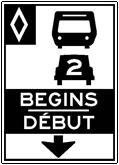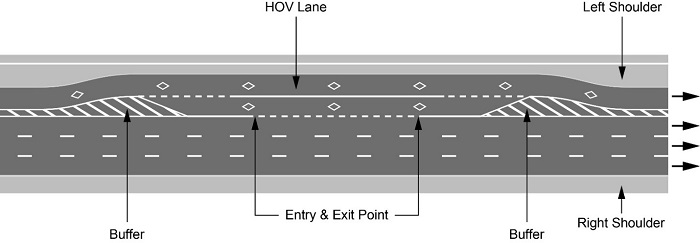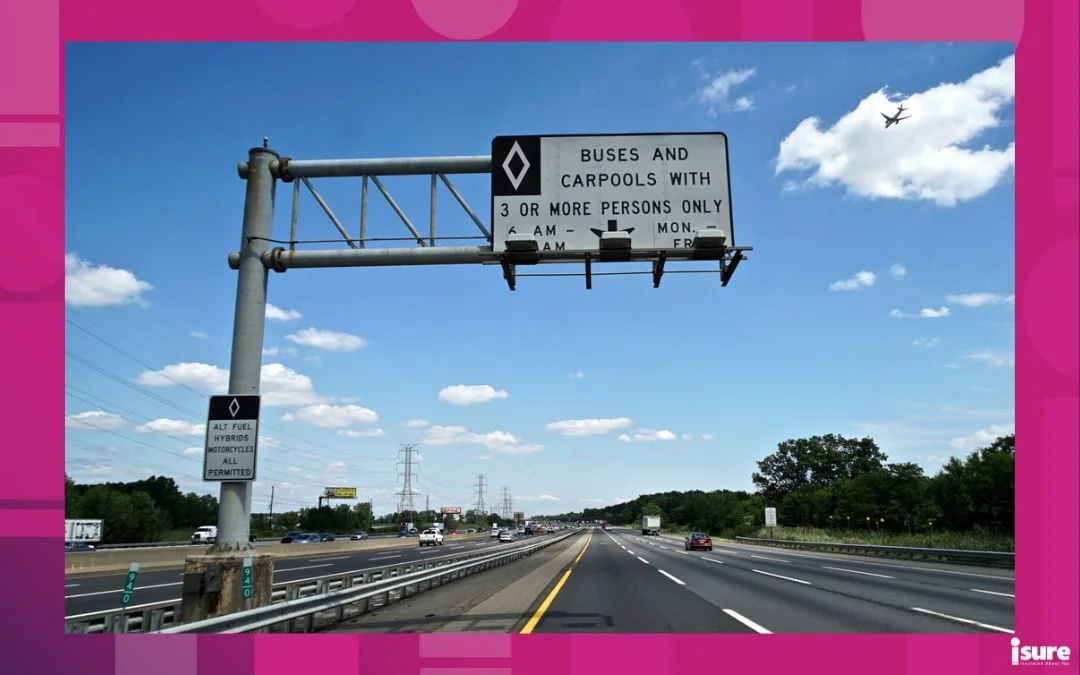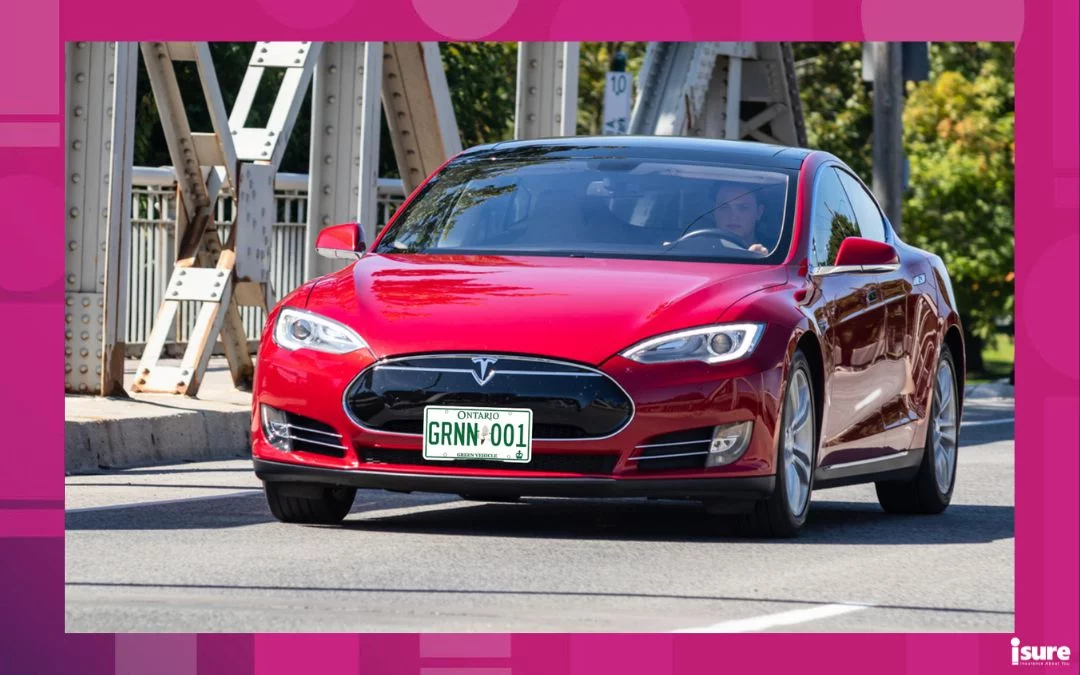Highways are designed for higher speeds of vehicle traffic. However, anyone that has ever travelled on a 400-series highway knows that this is not always the case. With the return back to the office and schools, Toronto highways are facing a familiar gridlock. To this end, city planners have been looking into ways to reduce traffic congestion. This has led to the creation of High Occupancy Vehicle, or HOV, lanes. While they can help to reduce traffic congestion, they aren’t for every car. Let’s learn more about HOV lanes and the rules you need to follow in order to have a quicker commute.
What are HOV lanes in Ontario?
High Occupancy Vehicle (HOV) lanes are designated lanes that can only be used by vehicles carrying two or more people or other specific types of vehicles, such as licensed taxis and motorcycles. In Ontario, HOV lanes are on the far-left side of the highway and are clearly marked by signs and pavement markings.

Benefits of HOV lanes in Ontario
- They encourage carpooling, and support hybrid and electric vehicles.
- HOV lanes in Ontario help to manage congestion
- They reduce transportation-related emissions and promote greener ways of travelling
- They optimize infrastructure investments – having fewer vehicles on the roads
How do I use an HOV lane?

HOV lanes are open to any vehicle to use if you have at least two people in the vehicle, including the driver. These vehicle types include:
- Car
- Van or light truck
- Commercial truck less than 6.5 meters long with a gross weight of 4,500 kg or less
- Vehicle towing a trailer with a combined vehicle-trailer length of less than 6.5 meters
Are there exceptions to the HOV lane rules?
While there are rules surrounding the use of HOV lanes, there are exceptions. The following vehicles can use the HOV lanes at all times, regardless of how many passengers they are carrying:
- Buses of all types
- Licensed taxis and airport limousines
- Emergency vehicles
- Vehicles with Ontario green license plates
- Motorcycles
Important: Some HOV lanes on the Queen Elizabeth Way (QEW), Highway 410 and Highway 403 can also be used by solo drivers with a High Occupancy Toll (HOT) lane permit as part of Ontario’s HOT lanes pilot program. To learn more, please click here.
Quick facts about HOV lanes in Ontario
- HOV lanes in Ontario are being added to most of the 400-series highways, but as of 2020, they exist on portions of the 400, 401, 404, 410 and 427.
- There is a striped buffer zone that separates the HOV lane from the rest of the highway. Don’t cross that zone once in or outside of the HOV lane!
- Vehicles with “green” licence plates can use these lanes at any time. Plug-in hybrid electric vehicles and full-battery electric vehicles are eligible for those plates, if you have one!
- Buses and emergency vehicles are permitted to use the lanes at any time.
If you see a sign that says HOV 3+, this means there must be more than two passengers and a driver in the vehicle for the lane to be used.
To use HOV lanes, be sure to look out for signs above the left lane:
- HOV signs located in the leftmost lane of the highway
- Markings on the road, including a striped buffer zone and diamond markings. The buffer zone separates the HOV lane from the rest of the lanes. If you don’t meet the lane requirements, you must change lanes before the HOV begins.
- It is only legal to enter an HOV lane when overhead signs permit you to do so. The road paintings are clearly defined by white broken lines. Failure to enter when it is legal can result in a ticket.
Find where HOV lanes are located at Ontario 511.
What are the fines for improper use of HOV lanes?
The HOV lanes are policed by the OPP as part of their regular highway enforcement. In March of 2021, OPP officers laid charges to 60 drivers in a single weekend for improper use of HOV lanes. You can receive a traffic ticket for:
- Not having two or more people in your vehicle
- Entering or exiting the HOV lane by crossing the striped buffer zone or solid line
- Using plastic objects or mannequins to mimic more people in your vehicle
- Driving over the posted speed limit
While the $110 fine for improper use of these lanes may not deter some, three demerit points may give others pause. Unlike a red-light camera or speed camera ticket, your insurance can find out about this one.
Green vehicles and HOV lanes in Ontario
If you are in possession of a hybrid vehicle or your vehicle carries a green licence plate, you can use these lanes anytime – even if you are alone in the car! As High Occupancy Vehicle lanes help curb emissions due to the fact that people are carpooling and/or driving ‘green’ vehicles, you can get to where you are going a little bit quicker by helping improve air quality and reducing the number of vehicles on the road.
For the convenience of a faster commute without necessarily needing to carpool, there is now a long list of vehicles that meet the “green” designation of the province. Every year it is growing, as manufacturers produce more and more BEVs, PHEVs and HFCVs. From Audi to Volkswagen, there are currently 30 different brands with products that qualify for a green plate. However, driving one of these vehicles doesn’t qualify you to use the HOV lane unless you’ve applied for and are sporting the actual green licence plates. Don’t worry thought, they cost the same as normal plates.
Do HOV lanes work?
High Occupancy Vehicle lanes have shown to increase carpooling numbers, and highway capacity overall seems to be improving. Studies also show that travel times improve once lanes open on a highway.
FAQs
Why are they on the left-side of the highway?
It is safer to locate a highway HOV lane to the left because it minimizes lane change interactions. Since most interchange access is located on the right side, it is safer to keep HOV lanes to the left.
Are HOV lanes and ETR highways the same thing?
Express tolls allow single-occupant vehicles to pay and use the roads. In Ontario, drivers use the 407 ETR and can obtain a transponder for secure payment. HOT lanes are also being tested for use on Ontario highways.
Is passing in these lanes allowed?
Drivers are not permitted to pass in and out of HOV lanes, even where there is a broken white line. Doing so can result in a fine or ticket.
Can you pay to use HOV lanes in Ontario?
No. If you are a single occupant driver and wish to use the HOV lanes, you are out of luck. But, High Occupancy Toll (HOT) lanes provide the option for people driving alone to pay a fee to use the lane. Carpooling drivers and certain vehicles can use HOT lanes for free and do not need a permit.
What about HOV lanes in Toronto?
The City of Toronto requires three or more passengers in the vehicle to use HOV lanes. With the high volume of traffic on city streets, it was thought that having a minimum of two people would result in high levels of carpools utilizing the HOV lane. As such, it was felt that the travel time incentives for using HOV lanes would only be beneficial with a higher occupancy, offering a quicker lane for those driving in it. To improve travel times by having more occupants in the car would, in turn, reduce the number of vehicles on the already congested roads.
Green vehicles are not exempt from city laws. Vehicles need to have three or more occupants. The fine for illegally driving in an HOV lane in Toronto is $110 and three demerit points.
Plan ahead!
Your daily commute doesn’t have to be the worst part of your day. If you are commuting to work or planning your next road trip, plan ahead. Using HOV lanes and carpooling can help decrease the amount of overall traffic congestion on the roads, while cutting down on your travel time.





